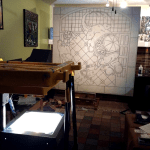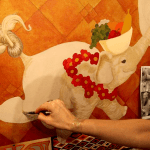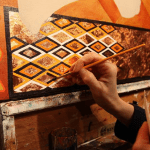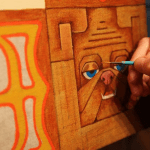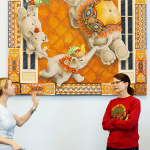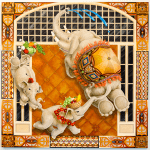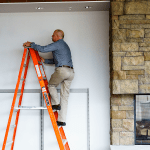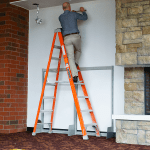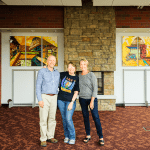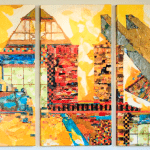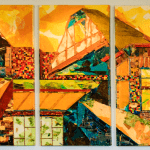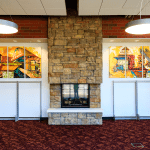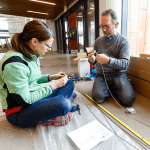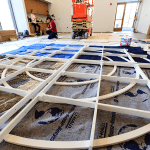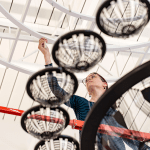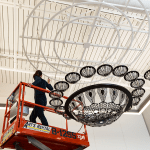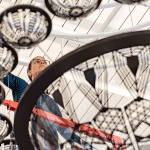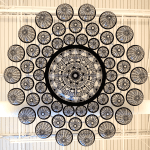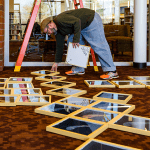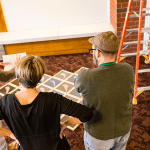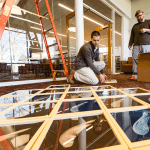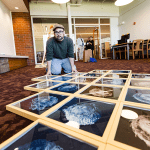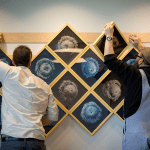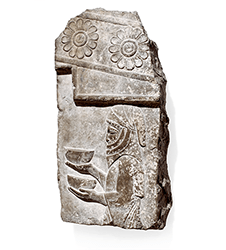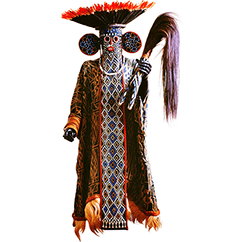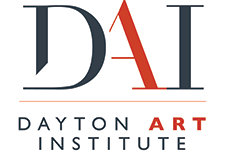NORTHWEST
About the Northwest Art Installation and Artists
Kollar Anderson was inspired by the rich patterns, bold color and variety of textures found in the Kuosi Society Costume from The Dayton Art Institute’s permanent collection. This work by Kollar Anderson overlaps realistic forms and decorative elements combining them with non-traditional material choices.
About the Artist
AMY KOLLAR ANDERSON creates surreal narrative paintings inspired by natural forms, decorative arts and her love of animals. She received her BFA from The School of the Art Institute of Chicago and a Master of Humanities from Wright State University. She lives with her husband and their four cats in Dayton. To learn more please visit Amy's website at www.kollaranderson.com.
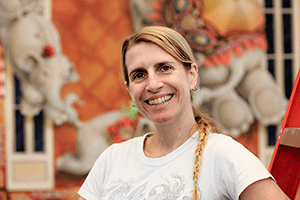
Marsha Monroe Pippenger (b.1957) American, SPACES BETWEEN STONES, 2015, Papier collé and mixed media. Collection of the Dayton Metro Library, 2016.3
Pippenger’s work was inspired by the Relief Fragment from Persepolis from the collection of The Dayton Art Institute. The two tryptychs reference the three library branches that combined to form the new Northwest Branch. Pippenger creates collages of paper on canvas in a process of building and layering, of adding and taking away, combining dissimilar items into a cohesive whole.
About the Artist
MARSHA PIPPENGER has been active in Dayton’s arts community for more than 20 years. She holds a BFA from Ohio Northern University and a Master of Humanities from Wright State University. Marsha is an adjunct faculty member at Wright State University and the Kettering College of Medical Arts.
For more information please visit Marsha's website at www.pippengerart.com.
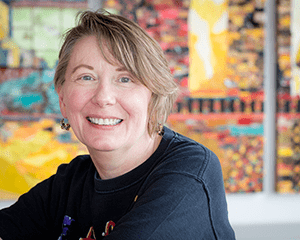
Virginia Kistler (b. 1976) American,UNTITLED, 2015, Rubber, stainless steel, wood. Collection of the Dayton Metro Library, 2016.2
The Kuosi Society Costume from the Bamileke people and the Relief Fragment from Persepolis, both from the Dayton Aart Institute’s permanent collection were chosen by the artist as inspiration for this work.
About the Artist
VIRGINIA KISTLER attended The Ohio State University and the Columbus College of Art and Design. She is an interdisciplinary artist working primarily in sculpture and photography while using a variety of media—laser cut rubber, cnc router-cut plastic, and 3D printed plastic. Virginia lives and works in Gahanna, Ohio. For more information please visit Virginia's website at www.virginiakistler.com.

Francis Schanberger (b.1965) American, SCATTER HOARD, 2015, Cyanotype and Vandyke prints on washi (Japanese paper). Collection of the Dayton Metro Library, 2016.4
Francis Schanberger’s work was inspired by the Kuosi Society Costume from The Dayton Art Institute’s permanent collection. The textile designs in the central part of the costume comprised of diamond shapes set within other diamond shapes with alternating cool and warm hues were the starting point for Schanberger’s work.
About the Artist
FRANCIS SCHANBERGER Dayton artist Francis Schanberger has been photographing since fourth grade when he presented a homemade, long focal length pinhole camera as his science project. Since then Schanberger has studied photography and developed his interest in historical photographic processes, receiving his MFA from Ohio State University. For more information please visit his website at www.francisschanberger.com.
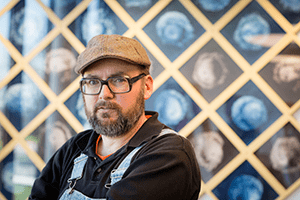
The Stories Behind the Miami Township Art Inspiration
From the Collection of the Dayton Art Institute
Relief Fragment from Persepolis, Persian (Achaemenid Empire), c. 518 - 465 BCE, Carved gray stone, 21 ½ x 11 ¼ x 3 inches, The Dayton Art Institute, Museum purchase with funds provided by the Hipple Foundation, 1967.60
Persepolis was built for the express purpose of holding ceremonies, receiving tributes and showing off. The reliefs that covered the city's walls depicted subjects from all over the Achaemenid (ancient Persian) Empire bringing gifts of tribute to the king for the Spring New Year festival, Nowruz. Stone relief carvings were also prominently featured in Fairview High School. Relief techniques, such as embossing, incising and carving are a rich tradition in contemporary craft.
View this artwork and learn more by clicking here, opens a new window or visit The Dayton Art Institute.
Bamileke people, Cameroon, Kuosi (Elephant Mask) Society Costume, 19th and 20th century, Fabric, fur, hair, beads, ivory, feathers, twine, Overall Height: 67 inches, The Dayton Art Institute, Museum purchase with funds provided by Dianne Komminsk, 1999.76
Costumed Kuosi society members performed a special dance in honor of the king every two years, thereby protecting his power symbolically. Both elephants and beadwork are symbols of political power in the kingdoms of the Cameroon grasslands. This object makes use of both man-made and natural materials.
View this artwork and learn more by clicking here, opens a new window or visit The Dayton Art Institute.
How did these pieces inspired our artists?
"The land where the Northwest Library branch stands was once occupied by Fairview High School (FHS). My painting pays homage to this history by combining FHS elements with the beauty of the Kuosi Society Costume, and the motto of the Dayton Public Library, which identifies itself as the ‘marketplace of the mind.’ A mother elephant and her calves float surrealistically in front of a structure inspired by the front entrance of FHS. They carry healthy food from the market. Bulldogs, the FHS mascot, anchor the corners of the decorative border which vibrates with colors and patterning drawn from the Kuosi Society Costume." - Amy Kollar Anderson, artist
"Like the stone Relief Fragment from Persepolis the viewer sees fragments of wall and “spaces between stones” in my work. I see walls as positive rather than negative symbols of community and just as the leaders of Persepolis united their empire, the double triptych design and architectural composition allude to the union of three unique neighborhoods – Northtown Shiloh, Dayton View/Salem and Ft. McKinley – into one library branch." - Marsha Monroe Pippenger, artist
"My work is a contemporary take on the traditional craft of textiles, inspired by the Relief Fragment from Persepolis and the Kuosi Society Costume. To contemporize the craft, I used laser cut, synthetic rubber. Like many Persian and Bamileke textiles, I employed the use of radial symmetry. If you look closely at the work, you will see textile patterns that are inspired by both cultures." - Virginia Kistler, artist
"The cyanotype process produces the cool blue hue and the Vandyke process produces the warm chocolate brown hue. My photographs of maple seeds and burr oak acorns are assembled in a quilt like pattern of these alternating colors." - Francis Schanberger, photographer
Thank you to our partner,
the Dayton Art Institute, opens a new window.
Photos of ReImagining Works pieces taken by Andy Snow.

